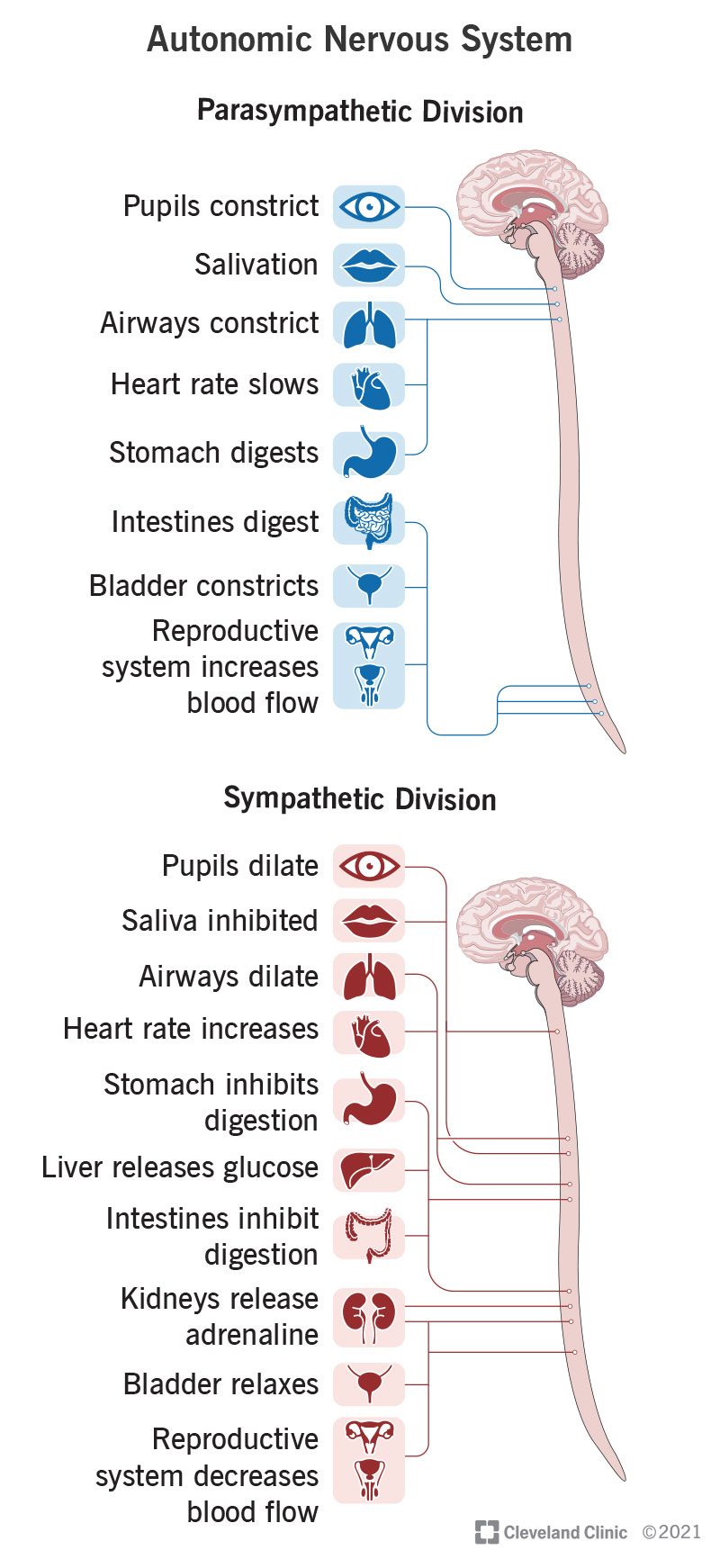Autonomic Nervous System: Definition, Functions, and Associated Disorders
What is the Autonomic Nervous System?
What is the Autonomic Nervous System?
Imagine you’re walking through a dense forest, and suddenly you hear a rustling in the bushes. Your heart starts racing, your senses become heightened, and you’re ready to either fight or flee. This instantaneous response is thanks to your autonomic nervous system (ANS), a remarkable network of nerves that regulates your body’s involuntary functions.
The autonomic nervous system is a branch of the peripheral nervous system that controls various autonomic functions, such as heart rate, blood pressure, digestion, respiration, and body temperature. It operates independently of your conscious mind, making decisions without your voluntary input.
The ANS has two main divisions: the sympathetic nervous system (SNS) and the parasympathetic nervous system (PNS). These systems work together to maintain homeostasis, a state of balance, within your body.
The Sympathetic Nervous System: The “Fight or Flight” Response
The SNS, often referred to as the “fight or flight” response, prepares your body to confront or flee from danger. Your heart rate increases, blood vessels constrict, and energy is released from stored fat cells. For example, when someone cuts you off while driving, your SNS triggers a surge of adrenaline, leading to increased heart rate and heightened alertness.
Chronic activation of the SNS can lead to stress, anxiety, and cardiovascular disease, emphasizing the importance of balance in the ANS.
The Parasympathetic Nervous System: The “Rest and Digest” Response
The PNS promotes relaxation and restoration. When activated, your heart rate slows, your blood vessels dilate, and digestion is enhanced. For instance, enjoying a warm bath allows your PNS to induce a sense of calm and relaxation, slowing your heart rate and enabling your mind to unwind.
Understanding the ANS in Everyday Life
The ANS is crucial for maintaining your overall health and well-being. Proper functioning allows you to respond to stressors, relax, recover, and maintain a balance between activity and rest. However, dysfunction can lead to disorders such as hypertension, anxiety, and gastrointestinal problems. Techniques including exercise, meditation, yoga, and deep breathing can promote ANS balance.
By exploring the functionalities of the ANS, you can leverage tools from GoblinX, such as guided meditations and stress-relief exercises, to support your mental health, especially for anxiety and ADHD. You can learn more about how to integrate these resources into your daily routine on the GoblinX website.

It acts largely unconsciously and regulates bodily functions such as heart rate, digestion, and breathing.
Acting Beneath the Surface: Unconscious Regulation of Bodily Functions
Imagine going for a run on a sweltering summer day. While you focus on running, the ANS ensures that your heart rate, breathing, and other unconscious processes continue seamlessly. This network works in tandem with the central nervous system (CNS), responding to stimuli to maintain homeostasis.
To navigate the nuances of the ANS, it’s vital to understand its two branches: the SNS and PNS.
...
The term “autonomic nervous system” was first coined in the late 19th century.
The term was introduced by John Newport Langley, marking a significant milestone in comprehending the intricate interplay between the body’s voluntary and involuntary functions. The ANS has evolved in importance, underpinning numerous physiological processes and impacting research on various health conditions.
This ongoing exploration into the ANS and its role reveals the complex relationships within our bodies. Continuous research is unlocking new insights and practical applications, making this knowledge essential for enhancing our health and well-being.
Discover how GoblinX can further assist you in managing anxiety and ADHD by providing tools that promote relaxation and a balanced state of mind. Engage with their resources for a more profound understanding of your autonomic responses.
Common Disorders and Conditions
The ANS plays a crucial role in regulating bodily functions, but disorders can disrupt this balance. Understanding conditions like Postural Orthostatic Tachycardia Syndrome (POTS), vasovagal syncope, and dysautonomia is vital for managing health outcomes effectively.
Integration of mindfulness and relaxation techniques, available through GoblinX, can be pivotal for individuals experiencing these disorders, fostering a balance within the ANS.
Understanding key parts and functions of the ANS leads to a deeper appreciation of its significance in our health. Through continued education and research, including the exploration of related concepts like the gut-brain axis, we can further enhance our grasp of this vital system.
| Autonomic nervous system - Wikipedia | The autonomic nervous system (ANS) is a division of the nervous system that operates internal organs, smooth muscle and glands. |
| Anatomy, Autonomic Nervous System - StatPearls | |
| Autonomic nervous system | Divisions & Functions | |
| Autonomic nervous system: Anatomy, divisions, function - Kenhub | Learn about the autonomic nervous system (ANS), which controls internal organs unconsciously. |
| Autonomic Nervous System (ANS): What It Is and … | |
| Autonomic Nervous System: Function and Divisions | |
| The Autonomic Nervous System: Anatomy and … | |
| Autonomic Nervous System: What to Know - WebMD | Learn about the ANS and its role in unconscious activities like breathing and digestion. |